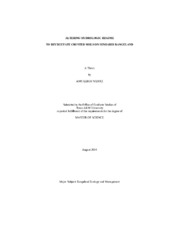| dc.description.abstract | Dysfunctional rangelands lose nutrients and material faster than they capture or create them. The objective of this study was to determine the effectiveness of contour furrows, drill seeding, and aeration treatments in capturing overland flow, concentrating resources, and establishing perennial bunch grasses to convert dysfunctional semiarid rangeland to a functional rangeland. The site, located on the Edwards Plateau in west Texas, USA, had bare, structurally crusted soils with sparse short-grasses (Scleropogon brevifolius). The site had a low infiltration rate contributing to excess overland flow and loss of nutrients, organic matter, and soil. Contour furrows were installed with varying intra-furrow distances (0.6 to 61 m) and then broadcast seeded to determine if furrow spacing would produce a vegetative response. Portions of the intra-furrow areas were aerated and drill seeded. All seed mixes contained warm season, perennial bunch grasses (Bouteloua curtipendula, Leptochloa dubia, and Setaria leucopila). Soil beneath furrows had greater soil water content (p-value < 0.05) than intra-furrow areas. Furrow plots had greater density of seeded grasses and total vegetation (19 individuals m-2 and 191 individuals m-2, respectively) than intra-furrow plots (0 individuals m-2 and 89 individuals m-2, respectively). This study supports other findings that suggest 1.5 m to 1.8 m is optimum intra-furrow spacing. Vegetative responses to drill seeding and aeration treatments were insignificant. Observations suggest that contour furrows are effective at establishment and support of perennial vegetation by capturing and retaining water that otherwise would be lost to runoff from untreated soil. | en |


